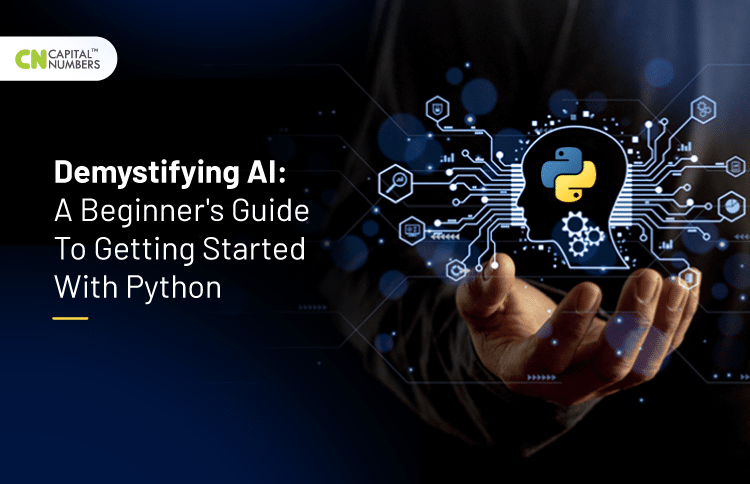Demystifying AI : A Beginner’s Guide to Getting Started with Python
Table of Contents
Artificial intelligence (AI) has become increasingly powerful in today’s technology-driven environment. It is employed across various applications, including intelligent robotics and automated vehicles, to develop systems capable of intelligent decision-making and to automate problem-solving processes. The impact of AI on various industries is profound, marking a significant shift towards operational models that are more efficient, innovative, and sophisticated.
Python is a leading choice among programming languages for developing AI systems, owing to its extensive libraries, user-friendly syntax, ease of learning, flexibility, and active community support. Key libraries such as PyTorch and TensorFlow, which are widely supported within the Python ecosystem, significantly accelerate the development process. The simplicity of Python’s syntax enables developers to write robust code efficiently, allowing them to focus more on innovating with AI algorithms.
In this article, we will explore AI and discuss how to kick-start your journey using the widely acclaimed programming language, Python.
About Artificial Intelligence
Creating computer systems or other machines with artificial intelligence makes them capable of activities that normally need human intelligence. It indicates that tasks carried out by AI systems rely on the processing and interpretation of data. These systems are designed to analyze data, spot patterns, draw knowledge from past experiences, and make decisions based on data processing.
About Machine Learning and Deep Learning
Machine Learning is a branch of artificial intelligence. Machine learning aims to create automated processes or algorithms that can learn without explicit programming.
Deep Learning is a branch of machine learning. ChatGPT, automated driving cars, and other automated systems are developed using deep learning. The fundamental ideas involve evaluating unstructured data, such as text, photos, or videos, and developing deep learning algorithms to identify patterns and interpret them to create automated systems.
Exploring artificial intelligence, machine learning, and deep learning shows a world where computers act like humans, making decisions based on data and recognizing patterns. In this field, machine learning and deep learning are crucial for innovations like self-driving cars and talking computers. They lead to advanced AI/ML development services, turning unstructured data into actionable insights.
Why Do We Use Python for AI?
- Python is a highly capable programming language that has grown in popularity due to its ease of use and readability. The syntax in Python is quite intuitive. It has a large library support base. We can look at a few of the well-liked and practical Python packages for artificial intelligence before we get started. Going through these libraries is an excellent way to maximize your Python experience.
- PyTorch: An open-source machine learning framework called Pytorch is used to create and train deep learning systems that rely on neural networks. Facebook’s AI research team is behind its development. Many tech businesses, including Microsoft, SalesForce, Facebook, and others, use Pytorch, which is quite popular.
- TensorFlow: An open-source end-to-end machine learning library called TensorFlow creates effective machine learning algorithms. It enjoys strong community support, which contributes to its ongoing development. Robust machine learning, model building, and flexible architecture are some of the fundamental aspects that support research-oriented development.
- Keras: Keras is a straightforward, incredibly versatile, powerful deep learning API built on Python. It uses the core Keras API, which is used to design sophisticated neural networks and train them. Additionally, it includes AutoKeras and Keras Tuner, which provide an automatic machine-learning system and an optimization framework.
- NumPy: Another well-known Python library is NumPy. It provides access to numerical computing tools together with scientific calculations. NumPy is incredibly user-friendly, open-source, and has sophisticated n-dimensional arrays.
- NLTK: Access to human language data is made easier with the help of the Python-based Natural Language Toolkit (NLTK). We can develop voice assistants and other language-processing apps. It is compatible with Linux, Mac OS X, and Windows and offers high-quality tutorials.
- Scikit-Learn: It is a Python machine-learning package that is employed in the analysis of predicted data. Other well-known libraries like SciPy, NumPy, and matplotlib are used in its construction.
Python-Based Artificial Intelligence Processes
Collection of Data: Compiling and organizing data from various sources is the initial step in the process. Data sources include things like social media, user reviews, and sensors. After the data is obtained, it must be cleaned up and put into the right format for analysis.
Machine Learning: The creation of machine learning algorithms is the next step. These algorithms are employed in the analysis and forecasting of data analysis. This aids in training AI-based systems to identify relationships and patterns in datasets. After that, the algorithm makes predictions or decisions based on these patterns.
Deep Learning: Neural networks are utilized in deep learning, a kind of machine learning, to identify patterns and relationships in data. These neural networks involve data analysis and learning through interconnected nodes.
Natural Language Processing: Natural language processing, or NLP, is the process of making machines or systems understand human language. Machines are trained on vast amounts of text data, and patterns and connections are found using algorithms.
Enhancement: The AI system must then be optimized after it has been trained. The purpose of this procedure is to improve its efficiency. In this procedure, the algorithms are modified using various test cases and parameter values, and the system is subsequently tested using fresh data.
Implementation: The AI system’s implementation is the last step. Either an entirely new system must be developed for the AI machines, or the machines must be merged with existing ones. We refer to this procedure as deployment.
Process of Machine Learning
It takes seven steps to learn machine learning. These are the steps we must take to address a problem. It must also develop a predictive model that resolves the specified issue.
The following are the seven steps needed for the machine learning process:
- Identify the goal
- Compile information
- Get ready data
- Analyse exploratory data
- Construct a Model for Machine Learning
- Assessment and optimisation
- Forecasts
Prior to Beginning
You must complete a few prerequisite tasks before using Python for machine learning. First, see how well you can do maths. Artificial intelligence depends largely on this. The following must be covered as a basic necessity:
- Linear Algebra For Data Analysis: The key ideas for data analysis include vectors, scalers, tensors, and matrices.
- Mathematical Analysis: In this scenario, gradients and derivatives must be the main discussion topics.
Future of AI
AI has a bright future ahead of it. According to experts, artificial intelligence (AI) will continue to advance quickly and provide answers to various problems. As technology advances, artificial intelligence is expected to become more commonplace in the finance, transportation, and healthcare industries.
Application in Finance: Artificial Intelligence (AI) enables financial firms to expedite and automate laborious and traditionally manual processes, such as market research. With AI’s speedy analysis of massive data sets, investors can track the growth of their investments and assess risk by seeing patterns and predicting future performance. AI and ML have the potential to enhance the overall banking client experience. The advent of Internet banking, sometimes known as contactless banking, reduces the necessity for face-to-face encounters. Numerous routine banking tasks, including transfers, deposits, payments, and customer care inquiries, can be automated by AI. AI can also manage the approval and rejection of credit card and loan application processes with nearly instantaneous results.
You May Also Read: AI-Powered FinTech: The Future of Financial Software Development
Application in Transportation: In the near future, more personal and business autonomous vehicles will be on the road. The most striking example of our arrival in the AI era will likely be the transportation sector, which includes everything from the cars many of us drive to work to the trucks that haul products down the highway to the spacecraft that carry people and things to the moon.
Application in Healthcare: AI will probably become a common tool used by physicians and physician assistants who perform diagnostic work. The general public should anticipate a rise in correct medical diagnoses. However, the delicate nature of patient information and the difficulty in understanding the regulations that safeguard it will also likely result in an even more convoluted legal landscape for medicine and higher operating expenses.
Application in Education: AI in education will transform learning for people of all ages. Artificial intelligence (AI) uses machine learning, natural language processing, and facial recognition to digitize textbooks, identify plagiarism, and measure student’s moods to determine who is having difficulty or is bored. In the present and the future, artificial intelligence will customize the learning process to meet the demands of each learner. Training and instructional materials will be provided to students based on their individual needs. AI will also choose the best teaching methods for each student’s unique learning preferences.
Application in Customer Service: Chatbots and virtual assistants are among the most popular applications of generative AI transforming the customer service sector. Companies now employ chatbots, ranging in complexity, to answer standard inquiries like calendar schedules, delivery dates, and other information obtained from internal systems. Artificial intelligence in customer service can give the sector data-driven tools that offer valuable information to the provider and the consumer.
You May Also Read: The Future of Client Relations in IT Services: An AI Perspective
Risks Associated With AI
- The decision-making process in AI is opaque.
- Cybersecurity and data privacy.
- Automated weapons systems
- Bias in algorithms due to poor data.
- Economic Inequality
- False Information and Deception
- Reduced Human Engagement
- Employment consequences and job reduction.
Experts believe that government legislation can be enacted to maximize AI’s benefits and minimize its threats. Therefore, it is time for the government to act and establish laws enabling everyone to benefit from AI.
You May Also Read: How AI and Machine Learning Can Transform Your Business
Conclusion
In conclusion, artificial intelligence is transforming our current landscape and shaping the future of digital transformation, holding immense potential to revolutionize how we live and work. We can actively contribute to its development and application by understanding its fundamentals. Artificial intelligence has vast applications running currently, but it is still in its early stages of development. AI with Python is an exciting journey that opens doors to endless possibilities. If you’re interested in the exciting world of AI, Python is your gateway to building smart machines that can change the world.

















